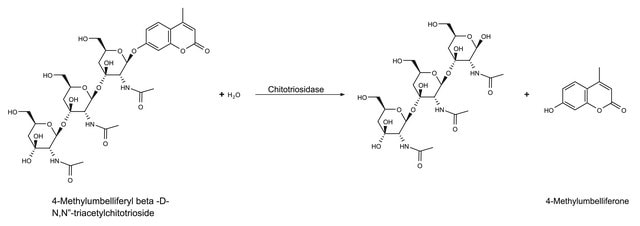CS1030
Chitinase Assay Kit, Fluorimetric
sufficient for 200 multiwell tests
Sinonimo/i:
Chitinase Detection Kit
Autenticatiper visualizzare i prezzi riservati alla tua organizzazione & contrattuali
About This Item
Codice UNSPSC:
12161503
NACRES:
NA.84
Prodotti consigliati
impiego
sufficient for 200 multiwell tests
Livello qualitativo
Condizioni di spedizione
wet ice
Temperatura di conservazione
−20°C
Informazioni sul gene
human ... CHIT1(1118)
Descrizione generale
The kit assay is based on the enzymatic hydrolysis of chitinase substrates. This enzymatic hydrolysis releases 4-methylumbelliferone (4MU), which upon ionization in basic pH, can be measured fluorimetrically at an excitation wavelength of 360 nm and an emission wavelength of 450 nm. The use of fluorimetric substrates provides a very sensitive detection system.
Applicazioni
The Chitinase Assay Kit provides all the reagents required for efficient and sensitive detection of chitinase activity in fungal and bacterial growth media, macrophage lysates, and purified enzyme preparations. In addition, the kit provides three different substrates for the detection of the various types of the chitinolytic activity:
- 4-Methylumbelliferyl N,N′-diacetyl-β-D-chitobioside - substrate suitable for exochitinase activity detection (chitobiosidase activity)
- 4-Methylumbelliferyl N-acetyl-β-D-glucosaminide - substrate suitable for exochitinase activity detection (β-N-acetylglucosaminidase activity)
- 4-Methylumbelliferyl β-D-N,N′,N′′-triacetylchitotriose - substrate suitable for endochitinase activity detection
Azioni biochim/fisiol
Chitinase catalyzes the hydrolytic cleavage of the β-1→4-glycoside bond present in biopolymers of N-acetylglucosamine, primarily in chitin. Chitinases are widely distributed in living organisms and are found in fungi, bacteria, parasites, plants, and animals. They are classified in families based on amino acid sequence similarities.
The chitinolytic enzymes are also categorized based on their enzymatic action on chitin substrates. Endochitinases are defined as the enzymes catalyzing the random cleavage at internal points in the chitin chain. Exochitinases catalyze the progressive release of acetylchitobiose or N-acetylglucosamine from the non-reducing end of chitin, and are referred to as chitobiosidase and β-N-acetylglucosaminidase, respectively.
Chitinases perform different functions in different organisms. In bacteria, they are mainly involved in nutritional processes. In yeast and various fungi, these enzymes participate in morphogenesis. In animals and plants, chitinases primarily play a role in the defense of the organism against pathogen attack.
The chitinolytic enzymes are also categorized based on their enzymatic action on chitin substrates. Endochitinases are defined as the enzymes catalyzing the random cleavage at internal points in the chitin chain. Exochitinases catalyze the progressive release of acetylchitobiose or N-acetylglucosamine from the non-reducing end of chitin, and are referred to as chitobiosidase and β-N-acetylglucosaminidase, respectively.
Chitinases perform different functions in different organisms. In bacteria, they are mainly involved in nutritional processes. In yeast and various fungi, these enzymes participate in morphogenesis. In animals and plants, chitinases primarily play a role in the defense of the organism against pathogen attack.
Compatibilità
The kit was tested and found suitable for Trichoderma viride and Streptomyces griseus, along with Hela, Jurkat, CHO, NIH-3T3, U-837 mammalian cell lines, human macropages, rat lung, kidney, liver, and brain tissue.
Nota sulla preparazione
Use ultrapure water for preparation of reagents.
Solo come componenti del kit
N° Catalogo
Descrizione
- Assay Buffer 25 mL
- 4-Methylumbelliferyl N-acetyl-β-D-glucosaminide 5 mg
- 4-Methylumbelliferyl β-D-N,N′-diacetylchitobioside hydrate 5 mg
- 4-Methylumbelliferyl β-D-N,N′,N′′-triacetylchitotriose 5 mg
- Chitinase from Trichoderma viride 1 mg
- 4-Methylumbelliferone Standard Solution, 50 mg/mL 1 mL
- Sodium Carbonate 2 g
- Dimethyl Sulfoxide 1 mL
Vedi tutto (8)
Avvertenze
Danger
Indicazioni di pericolo
Consigli di prudenza
Classi di pericolo
Eye Irrit. 2 - Resp. Sens. 1
Codice della classe di stoccaggio
10 - Combustible liquids
Punto d’infiammabilità (°F)
Not applicable
Punto d’infiammabilità (°C)
Not applicable
Certificati d'analisi (COA)
Cerca il Certificati d'analisi (COA) digitando il numero di lotto/batch corrispondente. I numeri di lotto o di batch sono stampati sull'etichetta dei prodotti dopo la parola ‘Lotto’ o ‘Batch’.
Possiedi già questo prodotto?
I documenti relativi ai prodotti acquistati recentemente sono disponibili nell’Archivio dei documenti.
I clienti hanno visto anche
Computational modeling and functional characterization of a GgChi: A class III chitinase from corms of Gladiolus grandiflorus
Rafiq M, et al.
The Kaohsiung Journal of Medical Sciences (2018)
Daniel Hartmann et al.
Future oncology (London, England), 11(2), 193-203 (2014-07-22)
N-acetyl-glucosaminidase (NAG) is a potential marker of genotoxicity. We retrospectively analyzed plasma NAG and clinico-pathologic features in advanced gastrointestinal adenocarcinoma patients. Plasma from 118 patients and 51 healthy volunteers was analyzed for associations between NAG levels and age, disease presence
S S Thimoteo et al.
Brazilian journal of medical and biological research = Revista brasileira de pesquisas medicas e biologicas, 50(1), e5658-e5658 (2017-01-12)
Chitinases are hydrolases that degrade chitin, a polymer of N-acetylglucosamine linked β(1-4) present in the exoskeleton of crustaceans, insects, nematodes and fungal cell walls. A metagenome fosmid library from a wastewater-contaminated soil was functionally screened for chitinase activity leading to
Zhangfa Song et al.
BMC cancer, 19(1), 629-629 (2019-06-27)
This study aimed to evaluate the value of chitinase activity in prognosticating the occurrence of metastasis in and prognosis of patients with colorectal cancer (CRC). The chitinase activity in four different groups, namely 335 CRC patients without distant metastasis at
Haoran Ma et al.
Journal of experimental botany, 67(19), 5799-5809 (2016-09-25)
Two unlinked semi-dominant loci, A (NIC1) and B (NIC2), control nicotine and related alkaloid biosynthesis in Burley tobaccos. Mutations in either or both loci (nic1 and nic2) lead to low nicotine phenotypes with altered environmental stress responses. Here we show
Il team dei nostri ricercatori vanta grande esperienza in tutte le aree della ricerca quali Life Science, scienza dei materiali, sintesi chimica, cromatografia, discipline analitiche, ecc..
Contatta l'Assistenza Tecnica.









